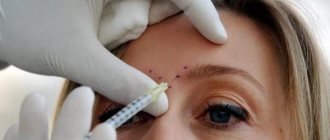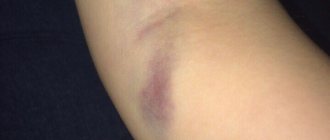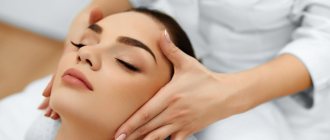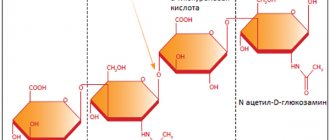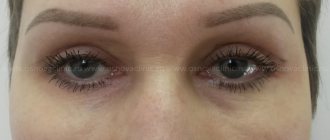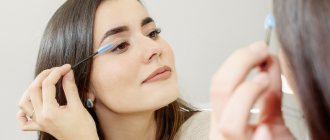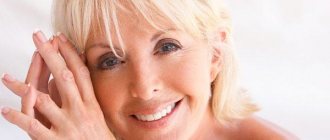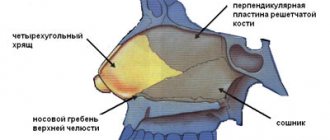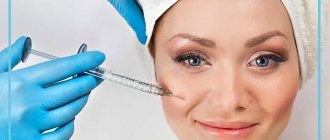Release form, packaging and composition of the drug Dysport®
| Lyophilisate for the preparation of solution for injection | 1 fl. |
| botulinum toxin type A complex - hemagglutinin | 500 units* |
Excipients: human albumin - 125 mcg, lactose monohydrate - 2.5 mg.
Glass bottles (1) in a cardboard holder - cardboard packs.
* ED is a unit of activity of the company.
Clinical and pharmacological group:
Muscle relaxant. Acetylcholine release inhibitor
Pharmacotherapeutic group:
MIBP
Why we recommend Dysport
In fact, both drugs have their advantages and their admirers. Who decides which composition is right for you?
Much has already been studied and written about the difference between Botox and Dysport. The effect is similar. The first drug is produced by an American company, the second is produced by a French company (made in France and the UK). Dysport contains lactose, and Botox contains sodium chloride. Dysport contains less botulinum toxin. Additional substances are auxiliary components, like human albumin. To give you an idea, Lantox is the result of the work of the Chinese and Germans. According to experts, they give results that last less than the duration of exposure.
Indications for the drug Dysport®
- blepharospasm, hemifacial spasm, spasmodic torticollis, spasticity of the arm muscles after a stroke, hyperkinetic folds (expression wrinkles) of the face in adults;
- dynamic foot deformity caused by spasticity in cerebral palsy in children aged 2 years and older;
- hyperhidrosis of the axillary region.
| ICD-10 code | Indication |
| G24.3 | Spasmodic torticollis |
| G24.5 | Blepharospasm |
| G80 | Cerebral paralysis |
| R25.2 | Cramp and spasm |
| R61 | Hyperhidrosis |
Administration zones
The drug Dysport is introduced into the body using injection injections. The areas for applying the cosmetic product are determined individually by the cosmetologist in the process of preparing the client for the procedure. Problem areas of the body that require contour correction or relaxation of excessively tense muscles are identified.
There are the following Dysport injection zones:
- cheek surface;
- eyebrow space;
- nasolabial folds;
- frontal lobe of the head;
- chin and the entire triangle of the nose;
- the entire surface of the neck;
- décolleté area, including its deep part;
- contour of the zygomatico-orbital joints;
- completely all areas of the oval of the face.
The cosmetic product can be dosed into other parts of the body where the sweat and sebaceous glands are concentrated. In this case, the effect of reducing excessive sweating is achieved, excessive activity of glandular tissues is removed, and the patient’s quality of life improves.
Dosage regimen
Bilateral and unilateral blepharospasm, hemifacial spasm
The contents of a bottle of 300 units are diluted in 1.5 ml of 0.9% sodium chloride solution for injection, the contents of a bottle of 500 units are diluted in 2.5 ml of 0.9% sodium chloride solution for injection. 1 ml of both solutions contains 200 units of the drug Dysport®.
For adults and elderly patients for the treatment of bilateral blepharospasm, the recommended starting dose is 120 units per eye. The drug is administered subcutaneously in a volume of 0.1 ml (20 units) medially, in a volume of 0.2 ml (40 units) laterally into the connection between the preseptal and orbital parts of the upper and lower parts of the circular muscle (m.orbicularis oculi) of the affected eye. For injections into the upper eyelid, the needle should be directed away from the center so as not to touch the muscle that lifts the upper eyelid (m.levator palpebrae superioris). Below is a diagram showing where the injections will take place.
The clinical effect can be expected within 2-4 days, the maximum therapeutic effect develops within 2 weeks.
Injections should be repeated every 12 weeks or as indicated to prevent recurrence of symptoms. With each subsequent administration, the dose of the drug should be reduced to 80 units per eye. For example, 0.1 ml (20 units) medially and 0.1 ml (20 units) laterally above the eye and below the eye. In the future, the dose of the drug can be reduced to 60 units per eye, by eliminating the introduction of the drug medially into the lower eyelid. The doctor determines subsequent doses in accordance with the effect obtained.
For unilateral blepharospasm, injections should be limited to the area of the affected eye. Similar treatment is carried out for hemifacial spasm.
Spasmodic torticollis
The contents of a bottle of 300 units are diluted in 0.6 ml of 0.9% sodium chloride solution for injection, and a bottle of 500 units is diluted in 1 ml of 0.9% sodium chloride solution for injection. 1 ml of both solutions contains 500 IU of the drug Dysport®.
Doses recommended for the treatment of torticollis are used in adults of all ages who have normal body weight and satisfactory neck muscle development. A reduction in the dose of the drug is possible in case of significant underweight or in elderly people with reduced muscle mass.
For the treatment of spastic torticollis, the initial total single dose is 500 units. This dose is distributed between the 2 or 3 most active muscles of the neck.
For rotational torticollis, the drug in a dose of 500 units is administered as follows: 350 units into the splenius capitis muscle, ipsilateral to the direction of head rotation, and 150 units into the sternocleidomastoid muscle, contralateral to the rotation.
For laterocollis (head-to-shoulder tilt), a dose of 500 IU is distributed as follows: 350 IU is injected ipsilaterally into the splenius capitis muscle (m. splenius capitis) and 150 IU - ipsilaterally into the sternocleidomastoid muscle (m. sternocleidomastoideus). In cases involving elevation of the shoulder by the trapezius muscle (m.trapezius) or the muscle that lifts the scapulae (m.levator scapulae), treatment may be required according to visible muscle hypertrophy or according to electromyography.
When injection of the drug into 3 muscles is required, a dose of 500 IU is distributed as follows: 300 IU is injected into the splenius capitis muscle, 100 IU into the sternocleidomastoid muscle (m.sternocleidomastoideus), 100 IU into the third muscle (trapezius or levator scapula).
For anterocollis (head tilt forward), 150 units are injected into both sternocleidomastoid muscles (m. sternocleidomastoideus).
For retrocollis (tilting the head back), a dose of 500 units is distributed as follows: 250 units are injected into each splenius capitis muscle. In case of insufficient clinical effect after injection, after 6 weeks the drug can be injected into the trapezius muscles (m.trapezius) bilaterally (at a dose of up to 250 IU per muscle). Bilateral injections into the splenius capitis muscle may increase the risk of developing neck muscle weakness.
When subsequently prescribing the drug, doses can be adapted in accordance with the clinical effect and side effects encountered. Recommended total doses are 250-1000 units. Use of the drug in higher doses may be accompanied by an increase in the frequency of side effects, in particular dysphagia.
Clinical improvement in spastic torticollis is observed within 1 week after injection. Injections should be repeated every 8-12 weeks or as needed.
For the treatment of other forms of torticollis, the use of electromyography (EMG) is of great importance to identify and administer the drug to the most active muscles. EMG should be used to diagnose all complex forms of torticollis or when re-examining patients with no positive dynamics after administration of the drug, for injections into deep muscles and in patients with excess body weight and difficult to palpate neck muscles.
Arm spasticity after stroke in adults
The indications for administration of the drug Dysport® in the treatment of arm spasticity after a stroke are determined by a neurologist 3 months after the stroke.
0.6 ml of 0.9% sodium chloride solution is injected into a bottle with the drug containing 300 units, and 1 ml of 0.9% sodium chloride solution is injected into the bottle with the drug containing 500 units. In both cases, receiving a solution containing 500 units of the drug Dysport® in 1 ml.
The maximum total single dose is 1000 IU, which is distributed between the following 5 muscles: flexor digitorum profundus, flexor digitorum superficialis, flexor carpi ulnaris, flexor radialis wrist (m.flexor carpi radialis) and biceps brachii (m.biceps brachii).
When choosing an injection site, one should be guided by standard EMG points, and the immediate injection site is determined by palpation. In all muscles, except the biceps brachii muscle, injections are made at one point. The injection is carried out into the biceps brachii muscle at 2 points. The recommended dose distribution between muscles is shown in the table.
| Muscles | Dysport® (IU) |
| Biceps brachii | 300-400 |
| Flexor digitorum profundus | 150 |
| Flexor digitorum superficialis | 150-250 |
| Flexor carpi ulnaris | 150 |
| Flexor carpi radialis | 150 |
| Total dose | 1000 |
The initial total dose of the drug can be reduced to 500 units to prevent excessive weakness of the injected muscles in cases where the target muscles are small in volume, when an injection into the biceps brachii muscle is not performed, or when patients are given an injection over several points of one muscle.
Clinical improvement occurs within 2 weeks after injection. Injections can be repeated approximately every 16 weeks or as needed to maintain effect, but no more frequently than every 12 weeks.
Hyperkinetic folds (expression wrinkles) of the face
The main area of application of Dysport® for cosmetic correction is the upper half of the face. The lower half of the face and neck are corrected by injecting botulinum toxin much less frequently.
The contents of the 300 IU bottle are diluted with 1.5 ml of 0.9% sodium chloride solution for injection, and the contents of the 500 IU bottle are diluted with 2.5 ml of 0.9% sodium chloride solution for injection. At this dilution, 1 ml of both solutions contains 200 units of the drug Dysport®.
The total recommended dose for a single administration in all four areas (the glabellar region, the forehead, the outer corner of the eye and the back of the nose) should not exceed 200 units of Dysport®.
To correct vertical folds in the eyebrow area, injections of the drug are made into the corrugator supercilii muscle, 8-10 units per 2-4 points, and into the procerus muscle, 5-10 units per 2 points. The total dose ranges from 42 to 100 units.
Elimination of hyperkinetic folds in the forehead area is carried out by injecting the drug into the area of maximum tension of the frontalis muscle (m.frontalis). The number of injection points can be arbitrary. All of them should be located 2 cm above the eyebrow line on the same line or in a V-shape. The optimal total dose of Dysport® in this area is 30-40 units (maximum - 90 units) at a rate of 5-15 units per point, the total number of points is 4-6.
Correction of folds in the area of the outer corner of the eye (“crow’s feet”) is carried out by subcutaneous injection into points located 1 cm lateral from the outer corner of the eye, at the rate of 5-15 IU of Dysport® per injection point. The number of points is from 2 to 4 for each eye. The maximum recommended total dose on both sides is 120 units.
The frequency of repeated injections depends on the timing of restoration of facial muscle activity. The duration of the effect is 3-4 months.
If an adequate dose of the drug was administered during the first injection, then during the second and subsequent injections the total dose of Dysport® can be reduced by 15-20 IU for the appropriate areas. In this case, it is possible to increase the interval between injections of the drug to 6-9 months. If the initial dose of the drug was insufficient, then with repeated injections it should be increased.
To correct wrinkles in the dorsum of the nose, injections are made into the middle of the belly of the nasal muscles. The dose is distributed at 5-10 units to 1-2 points in each muscle.
The muscle relaxant effect of the drug Dysport® on the facial muscles of the face is clinically manifested on days 2-3 after administration and reaches a maximum on days 14-15.
Recommended doses of Dysport® used in aesthetic medicine do not cause systemic side effects.
Dynamic foot deformity caused by spasticity in cerebral palsy in children aged 2 years and older
The contents of a bottle of 300 units are dissolved in 0.6 ml of 0.9% sodium chloride solution for injection, and the contents of a bottle of 500 units in 1 ml of 0.9% sodium chloride solution for injection, in both cases obtaining a solution containing 500 units in 1 ml.
The drug is administered intramuscularly into the calf muscles (m. gastrocnemius). The initial recommended dose is 20 units/kg body weight and is divided equally between the calf muscles (m. gastrocnemius). If one calf muscle is affected (m.gastrocnemius), the drug is administered at a dose of 10 U/kg. The optimal dose is determined individually; subsequent treatment should be planned after assessing the results of the initial dose. To avoid side effects, do not exceed the maximum dose of 1000 units. The drug is predominantly administered into the gastrocnemius muscle (m.gastrocnemius), but it is possible to inject it into the soleus muscle (m.soleus) and the tibialis posterior muscle (m.tibialis posterior). To determine the most active muscles, you can use the electromyography method.
In cases where the patient's target muscles are small in volume, the initial dose of the drug should be reduced to prevent the development of excessive weakness. Clinical improvement occurs within 2 weeks after administration of the drug. Injections are repeated as needed at intervals of at least 12 weeks, and the administered dose can vary from 10 to 30 units per 1 kg of body weight, depending on the effect of the previous injection.
Treatment of axillary hyperhidrosis
The contents of the 300 IU bottle are diluted with 1.5 ml of 0.9% sodium chloride solution for injection, and the contents of the 500 IU bottle are diluted with 2.5 ml of 0.9% sodium chloride solution for injection, obtaining in both cases a solution containing 200 IU in 1 ml.
The recommended starting dose is 100 units per axillary area. If the desired effect is not achieved, then a subsequent dose increase to 200 units is possible.
The area of drug administration is determined by Minor's test. The test is carried out before treatment and, if necessary, dynamically, at room temperature (22-24°C) after the patient has rested for 15 minutes. To carry out the test you need: 5% alcohol solution of iodine; potato starch; marker; antiseptic; brush; gauze napkins.
The patient is in a supine position with his hands under his head. The sweating area is treated with a 5% alcohol solution of iodine and after 1 minute a thin layer of potato starch is applied to this area with a napkin or brush. The test results are assessed after 5 minutes. In the presence of sweating, the treated surface is visually observed to turn blue. The intensity of color (from pale blue to blue-black) correlates with sweating activity. After the test, the area of hyperhidrosis is marked with a marker, then the starch is washed off with alcohol or another antiseptic.
Intradermal injections are carried out at ten points in each axillary area, 10 units of the drug in a volume of 0.05 ml are injected into each point, 100 units per area. The maximum therapeutic effect develops within 2 weeks. In most cases, the recommended starting dose suppresses sweating for up to 48 weeks. The frequency of repeated injections is determined individually when the initial level of sweating is restored, but not more often than once every 12 weeks. If there is any evidence of a cumulative effect with repeated injections, the timing of repeat injections is determined individually for each patient.
Preparation
Botox injections in the neck are carried out provided that the patient is completely healthy and feels well. The procedure requires simple preparation. A week before the manipulations, it is necessary to exclude from the diet salty, spicy, fatty foods that contribute to the formation of edema. In 2–3 days, you need to completely give up alcohol, limit physical activity, stop taking hormones, antibiotics and other medications prescribed by your doctor.
Immediately before administering botulinum toxin, the cosmetologist conducts a thorough examination of the problem area, assessing:
- type of wrinkles and the specifics of their location;
- Tugor;
- anatomical features.
Rules for preparing solution for injection
Remove the protective plastic tamper evident cap from the bottle.
When diluting the drug, do not open the bottle by removing the stopper. Immediately before diluting the contents of the bottle, the central part of the stopper should be treated with alcohol. The lyophilisate is diluted by introducing a regulated volume of 0.9% sodium chloride solution for injection into the bottle by piercing the stopper with a sterile needle of size 23 or 25. The resulting solution is a colorless transparent liquid. Since the drug does not contain a preservative, it is recommended to use it immediately after dissolution. The diluted drug can be stored for no more than 8 hours at a temperature of 2° to 8°C.
Rules for processing tools and waste disposal
Immediately after the injection, the remaining solution in the vial or syringe should be inactivated with a dilute sodium hypochlorite solution containing 1% active chlorine. All ancillary materials that have come into contact with the drug should be disposed of in accordance with standard hospital practice.
Spilled medication should be removed with an absorbent cloth soaked in 1% sodium hypochlorite solution.
How does the procedure work?
Injections do not cause intense pain in most patients; anesthesia is not used for injections.
- The cosmetologist marks out places for the injection of Dysport and disinfects the skin.
- The drug is administered with a thin needle in a calculated dosage.
- A cold compress is applied to the injection area.
- After removing the compress, the patient is allowed to go home.
The first effect becomes noticeable within three days. The pronounced result is visible within one and a half to two weeks from the moment of the procedure.
Side effect
During various clinical studies of the drug Dysport® involving about 7800 patients, adverse reactions developed with the following frequency: very often (≥1/10), often (≥1/100, up to General side effects
From the nervous system: rarely - neuralgic amyotrophy.
Dermatological reactions: rarely - skin rash.
Local reactions: often - pain and hematoma at the injection site; uncommon - irritation, burning sensation at the injection site, which lasts 1-2 minutes.
General reactions: often - general weakness, fatigue, flu-like syndrome.
Arm spasticity in adults after stroke
Adverse reactions were reported in 14 clinical studies involving 141 patients.
From the digestive system: often - dysphagia (has been reported when doses exceeding 2700 units were used, administered at one point or distributed between several points of administration).
From the musculoskeletal system: often - weakness of the arm muscles.
Other: often - accidental injury/fall.
Dynamic foot deformity caused by spasticity in children with cerebral palsy
Adverse reactions were reported in 14 clinical studies involving approximately 900 patients.
From the digestive system: often - diarrhea.
From the musculoskeletal system: often - weakness of the leg muscles.
From the urinary system: often - urinary incontinence.
Other: often - accidental injury due to a fall and abnormal gait, which are a consequence of excessive muscle weakness and/or spread of the action of the toxin to other muscles close to the injection site involved or involved in a certain motor act and in maintaining the balance of the patient's body in a standing position and when walking.
Spasmodic torticollis
Adverse reactions were reported in 21 clinical studies involving approximately 4,100 patients.
From the nervous system: often - dysphonia; infrequently - headache.
From the side of the organ of vision: infrequently - diplopia, impaired accommodation.
From the respiratory system: rarely - respiratory disorders.
From the digestive system: very often - dysphagia; Uncommon: dry mouth.
Dysphagia has a dose-dependent effect and occurs most often when the drug is administered into the sternocleidomastoid muscle. A diet excluding roughage may be required until symptoms resolve
Blepharospasm and hemifacial spasm
Adverse reactions were reported in 13 clinical studies involving approximately 1,400 patients.
From the nervous system: often - weakness of the facial muscles; infrequently - paresis of facial muscles.
From the organs of vision: very often - ptosis; often - diplopia, dry eyes, lacrimation; rarely - ophthalmoplegia.
Dermatological reactions: often - swelling of the eyelids; rarely - turn of the century.
A side effect may occur if the doctor fails to comply with the rules for performing the injection (dilution, accurate calculation of the administered dose, correct choice of injection points, direction of the needle and depth of injection) and the associated excessive diffusion of the drug and temporary paralysis of the muscle groups adjacent to the injection site.
Axillary hyperhidrosis
Adverse reactions were reported in 4 clinical studies involving approximately 217 patients.
Dermatological reactions: often - compensatory sweating.
Hyperkinetic folds (expression wrinkles) of the face
The following adverse reactions have been reported (usually mild to moderate in intensity).
From the organ of vision: often - swelling of the eyelids and mucous membrane of the eye; infrequently - dryness of the mucous membrane of the eye (keratoconjunctivitis sicca).
From the musculoskeletal system: often - weakness of the muscles adjacent to the injection site, which also often leads to ptosis of the eyelids, asthenopia (weakness of vision) or, rarely, to paresis of the facial muscles and visual disturbances.
From the nervous system: very often - headache (also often observed in the placebo group).
Dermatological reactions: infrequently - rash, itching; rarely - urticaria.
Local reactions: very often - pain, hematoma, itching, paresthesia, erythema, rash at the injection site (which were also often observed in the placebo group).
Post-registration experience of use
Most side effects are mild and transient.
Rarely: digestive disorders, allergic skin reactions, dizziness, headaches.
Very rare (1/10,000): severe muscle weakness, dysphagia, aspiration pneumonia, which can be fatal.
Advantages in cosmetology
Reviews from cosmetologists and patients who have used Dysport indicate that this is the best method for getting rid of wrinkles, folds, increased tone of muscle fibers in the eye area, between the eyebrows, around the mouth, and on the surface of the frontal lobe of the head.
The advantages of using the drug in the field of cosmetology are that specialists are able to provide the patient with the following rejuvenation effects:
- eliminate transverse wrinkles formed over many years as a result of laughter;
- raise the nasolabial folds that hang over the general contour of the face;
- remove wrinkles on the surface of the lower eyelid;
- relax the overly tense muscles of the facial disc, which are responsible for the chewing function (their hypertonicity creates the illusion of massiveness of the lower jaw);
- eliminate wrinkles around the eyes that appear due to poor vision or the habit of squinting;
- tighten epithelial tissue in the neck and décolleté area, which is especially important for women over 40 years old;
- straighten the contour of the oval of the face, restore its geometry and symmetry, which can be disrupted under the influence of age-related changes;
- raise the contour of the eyebrows and corners of the mouth, making the smile more feminine, harmonious and without exposing the gums;
- eliminate excessive sweating in certain areas of the body where a large number of sebaceous and sweat glands are concentrated.
During the administration of the drug, ultra-thin needles are used, which cause minimal damage to the skin. Dysport contains a small concentration of the neurotoxin butulina.
Due to this, there is an exclusively local effect of muscle relaxation without spreading the product into neighboring tissues and getting into the blood. Dysport injections have been used in the cosmetology industry for 20 years. At least 200 clinical trials have been completed, confirming the high effect and safety of the cosmetic product.
Contraindications for use
- acute diseases (the drug is administered after recovery);
- pregnancy;
- lactation period (breastfeeding);
- hypersensitivity to the components of the drug.
Use during pregnancy and breastfeeding
Dysport® is contraindicated for use during pregnancy and lactation (breastfeeding).
Studies of the effect of Dysport® on reproduction and teratogenicity have not been conducted. The safety of using Dysport® during pregnancy and breastfeeding has not been confirmed.
Use in elderly patients
It is possible to reduce the dose of the drug in elderly people with reduced muscle mass.
At the Academy VIP clinic in Nizhny Novgorod, procedures with Dysport are performed by cosmetologists of the highest category with more than 15 years of experience. In a multidisciplinary medical center, the patient can undergo a comprehensive examination to identify contraindications and receive recommendations on additional ways to improve skin texture.
- We work only with certified original Dysport. The effectiveness and safety of the procedure depends on this.
- The clinic complies with the storage conditions for the drug. If the temperature regime is not observed, use of Dysport is prohibited. We strictly comply with the manufacturer's requirements.
- We do not use an opened bottle for longer than the permissible period. The health of patients is our priority. We do everything to minimize the likelihood of complications.
- The clinic has all the conditions to provide assistance in case of an allergic reaction or other side effect.
You can make an appointment for a preliminary consultation with a VIP Academy cosmetologist by calling +7 (831) 200-47-38.
special instructions
Treatment with Dysport® should be carried out by specialists who have experience in diagnosing and treating these diseases and who have been trained to administer treatment with this drug.
Particular caution should be taken when re-introducing the drug to patients who have had allergic reactions to the previous injection.
Side effects resulting from the action of the toxin on muscles distant from the injection site have been reported. Patients receiving Dysport® at therapeutic doses may experience general muscle weakness. The risk of such side effects can be reduced by following drug dosage recommendations and using the drug in the minimum effective doses.
The drug is prescribed with caution and under strict medical supervision to patients with subclinical or clinical manifestations of lesions of neuromuscular transmission (for example, bulbospinal palsy). Such patients may have an increased sensitivity to botulinum toxin preparations, which can cause severe muscle weakness in them.
Dysport® should be administered with caution to patients with impaired swallowing and breathing functions, because these disorders may be aggravated due to the widespread effect of the toxin on the corresponding muscles.
In rare cases, patients suffering from chronic respiratory diseases may develop aspiration.
Isolated cases of death caused by dysphagia (impaired swallowing), pneumopathy, or in patients with significant asthenia have been reported during therapy with botulinum toxins type A and B.
Patients and those caring for them should be warned about the need to urgently consult a doctor in cases of swallowing, speech and breathing problems.
The formation of anti-botulinum antibodies was observed in a small number of patients who were treated with Dysport®. Clinically, this was manifested by a decrease in the therapeutic effect, which required a constant increase in drug doses.
In patients with a slow blood clotting time and inflammation at the intended injection site, Dysport® should be used in cases of extreme necessity.
The units of action of Dysport® are specific and cannot be compared with those of other drugs containing botulinum toxin.
Impact on the ability to drive vehicles and operate machinery
There are no data on the effect of the drug on the ability to drive vehicles and operate machinery.
Dysport: when does the effect occur?
It is worth warning right away that Dysport and Botox are drugs that do not have an immediate desired effect, but a long-lasting one.
This is why we value them. Although you will see the first changes within a few hours. To understand why this happens, let’s find out together what Dysport is, how long it takes to see the effect, and why injections with Botox and Dysport should only be done in trusted clinics and qualified specialists. Several decades ago, botulinum toxin, which is the basis of Dysport, had interesting side effects. Doctors noticed that in small quantities the substance “freezes” the muscles, and simply paralyzes them. Changes in muscle fibers lead to the fact that the skin becomes smooth, effectively stretched, wrinkles quickly disappear as they are smoothed out, and the face itself pleasantly relaxes. Previously, the properties of botulinum toxin were used to work with muscle tone, correct cosmetic defects, and also to combat excessive sweating in the armpits, feet and palms.
In cosmetology and aesthetic medicine, they began to use a version of the toxin that has undergone a special purification technique. We are accustomed to thinking of toxins as poisons, but in minimal quantities and with the use of certain components, such poisons become wonderful tools for wonderful transformations. This is how the drugs Botox and Dysport appeared. The effect of both was quickly appreciated by women who actively care for themselves and strive to restore youth to their skin or maintain it for as long as possible. Many of them breathed a sigh of relief, because everyone is thinking about being young and charming for as long as possible without plastic surgery.
Rehabilitation
During the rehabilitation period, the patient must monitor the hygiene of the part of the body where Dysport injections were administered. In the morning and evening, it is necessary to perform a drainage massage of the epithelial tissues, but without squeezing the skin.
Washing should be done with warm water and hypoallergenic soap. It is recommended to rinse the treated skin with chamomile decoction once a day. The average duration of the rehabilitation period is 7-14 days.
Anti-aging product price
The cost of a rejuvenating procedure directly depends on the number of injections required to achieve a cosmetic result, as well as the complexity of the work. On average, a session for smoothing wrinkles and relaxing muscles in a state of hypertonicity costs 4,500-8,000 rubles.
Reviews from patients and cosmetologists who have used the drug Dysport indicate a positive result in rejuvenation of the face and all parts of the body. This product contains botulinum neurotoxin, the concentration of which is safe for the human body.
The local action of injections ensures the local activity of the drug without its penetration into the blood and tissues of internal organs. Dysport is indicated for women over 30 years of age who are faced with the problem of facial wrinkles, impaired facial symmetry, and sagging skin.
Technique
The procedure for a cosmetology session for rejuvenating the skin of the face and other parts of the body using botulinum neurotoxin injections is performed using the following technique:
- The patient enters the sterile conditions of a cosmetology room designed specifically for such procedures.
- Sit down in a chair or lie down on a couch, depending on the area of application of Dysport.
- A cosmetologist performs antiseptic treatment of epithelial tissues.
- From 1 to 3 ml of the drug is taken into a disposable sterile syringe.
- The skin is pierced with a syringe needle, and the injection contents are injected into the epithelial and muscle tissues.
- After removing the needle, the skin is re-treated with an antiseptic solution.
The average duration of a cosmetology session is 15-20 minutes.
Upon completion, the patient can independently leave the clinic and return to their normal lifestyle. Complete restoration of the appearance and smoothing of the skin may occur after 2-3 weeks, but in most cases the cosmetic effect is noticeable much earlier.
